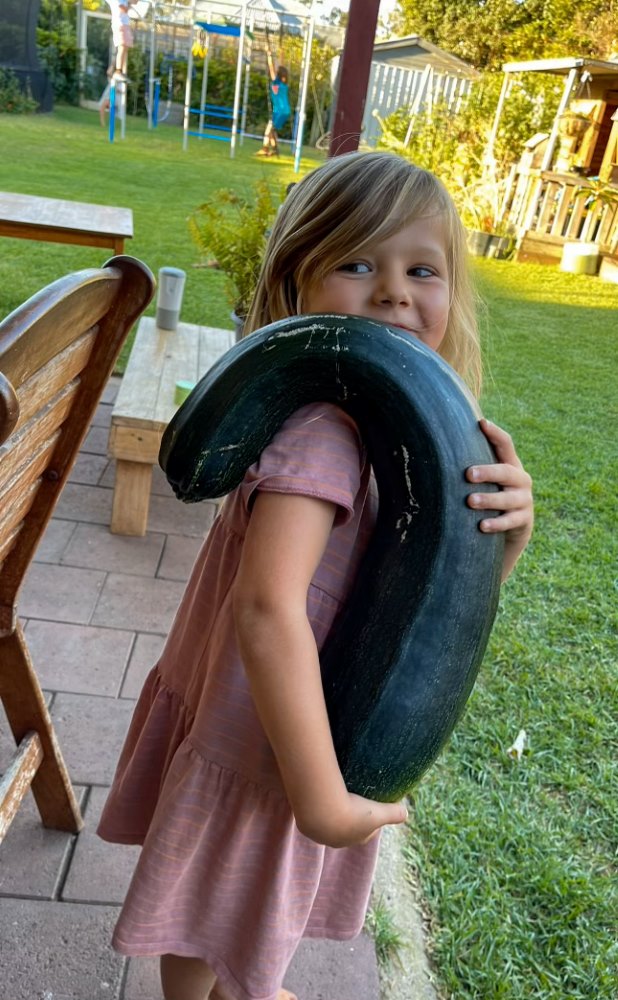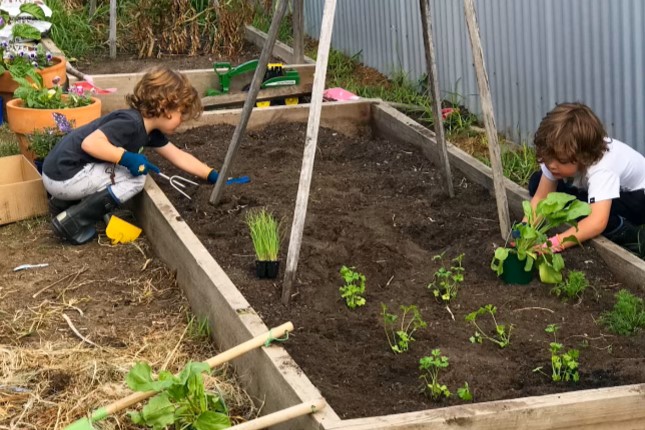
WORDS: Larissa Sewell
Spring is my absolute favourite time of year. It’s like a reward for making it to the other side of grey, rainy Adelaide winter; with our trademark bitterly cold houses. One of the very first things I do once the days get warmer and longer is get outside with the littles and work on my neglected winter garden. Preparing everything for a looong spring and summer season of edible everything, 7 foot high sunflowers, a tomato vine jungle and dinner plate sized dahlias.
Every year I share my garden on my Instagram stories, and every year I get dozens of messages and questions, so, I figured while I’m preparing for my own spring garden, that it would be a great time to share some tips on starting a kid-friendly garden with you guys.
Gardening with kids is not only a fantastic way to teach them about where food comes from, but it also offers so many benefits, from being physically active outdoors and replenishing those vitamin D stores; to developing patience and responsibility. Plus, there’s something so flippin’ exciting about watching tiny seeds grow into flourishing plants that you’re then able to pick and eat.
Gardening with kids is not only a fantastic way to teach them about where food comes from, but it also offers so many benefits, from being physically active outdoors and replenishing those vitamin D stores; to developing patience and responsibility.
The benefits of gardening with kids
Hands-on (or at least hands-in-dirt) learning: Gardening is a fantastic way for children to learn about seasons, nature, life cycles, and the environment. They get to see firsthand how plants grow from teeny-tiny little seeds into the vegetables, fruits and herbs that end up on their plates.
Healthy eating habits: I reckon kids who grow their own food are more likely to eat it. There’s a sense of pride and accomplishment in harvesting what they’ve planted, watered, watched and nurtured. I can’t under-state just how much more delicious a snow pea or a still-warm cherry tomato is when it’s freshly plucked off the vine, than when it’s been pulled out of a plastic container that’s been sitting on the supermarket shelf for potentially weeks.
Getting active in the sunshine: Digging, planting, watering, and weeding are all excellent forms of exercise. Gardening gets kids moving and helps improve their fine motor skills.
Stress relief and happy dirty hands: Just like adults, kids can benefit from the calming effects of being out in nature. Spending time outdoors, getting their hands dirty, and watching plants grow can be a great way for kids to unwind – and it’s the perfect antidote to excessive screen time. There’s also studies that show that physically getting your hands in the dirt and coming into contact with the soil and specific bacteria can increase serotonin levels; gardening can really make you feel happy!
Patience and responsibility: Gardening teaches kids to be patient and to take responsibility for their plants. They learn that plants need regular care and attention to thrive, which (even for us adults!) can be a valuable life lesson.

Starting your kid-friendly garden
You don’t need a sprawling backyard to start a garden; even the smallest spaces can be transformed into a lush, green mini-oasis with a bit of creativity (and a few trips to Bunnos).
1. Choose your space
If you have a backyard, fantastic! But if you’re short on space, there’s no need to worry; container gardening is a brilliant solution, even on balconies. You can grow a huge variety of plants in pots, tubs, or even recycled containers. Just make sure they have good drainage and are placed in a spot that gets plenty of sunlight.
2. Select kid-friendly plants
Start with plants that are easy to grow and fun to harvest. Here are some great options for spring:
- Herbs: Basil, mint, and parsley are all easy-to-grow herbs, and are really easy to incorporate into salads and dishes. Lettuce varieties are also quick growing and simple to grow in a pot.
- Vegetables: Peas (both shelling peas and snow peas) radishes, and cherry tomatoes are perfect for little hands to plant and pick. They’re sweet, delicious and relatively quick growers; so there’s not a huge time from seed-to-reward. The other thing I love about peas and cherry tomatoes is that when they’re looked after and happy they’ll produce for a long time.
- Fruits: Strawberries are an absolute hit with kids and are super easy to grow in pots. You can even grow different varieties of strawberries, including the very cool white strawberry, the ‘pine-berry’ – it tastes a little fruity like pineapple.
3. Get creative with containers
A fun way to engage littles is to let them decorate their own pots. Use paints, stickers, or even textas to add a splash of colour and creativity. You can also make plant name-tags from pop-sticks or clay to label each plant and remember what seeds were planted where, unlike me, who ends up with a lucky-dip of seedlings every. single. year. 🤣
4. Planting and caring for your garden
- Soil: Use a good quality potting mix. Your local garden centre can help you choose the right one for you. If container gardening, make sure your pots have drainage holes. I can’t stress enough to remember to wear a mask when handling potting mix to avoid inhaling any dust or spores – especially when pouring directly from the bag.
- Planting: Show your kids how to plant seeds or seedlings. Make small holes, place the seeds in, and cover them lightly with soil. Water gently but thoroughly – I actually like to buy little bottle-top waterers that screw on to existing PET bottles – I get these from The Diggers Club (which is located in the beautiful Adelaide Botanic Gardens – but warning – you’ll want to buy *everything*)
- Watering: Teach your children the importance of regular watering, especially as the weather gets warmer. As a general rule, you don’t want to ever let your soil for seedlings dry out entirely; this is even more important for container gardens. Early morning or late afternoon is the best time to water your plants.
- Weeding and general care: Get your kids involved in weeding and checking for pests. This helps them learn to care for their garden and keep it healthy. Just be careful not to ‘weed’ the little seedlings that pop up.
5. Harvest and enjoy the ‘fruits of your labour’
Once your plants start to bear fruit or vegetables, it’s *so exciting* to let your children do the harvesting. There’s nothing quite like the thrill of picking your own strawberries or pulling up a cute little radish straight from the soil. A little tip here (I speak from experience!) is sometimes kidlets get a little toooo eager to pick – and you can end up with little piles of green, under-ripe strawberries and tomatoes. I used to laminate a picture of a RED tomato or strawberry and stick it in the soil on a wooden stake, and we would ‘check’ that the one we wanted to pick ‘matched’ the colour on the card before plucking it off the vine. Sometimes worked – sometimes, well, we were still too eager 😅

Tips for success
- Start small: Don’t overwhelm your kids (or yourself) with too many plants. A few pots are plenty to start with – there’s always next year to introduce more.
- Be patient: Not all plants will grow perfectly, and that’s okay. Gardening is a learning process
- Have fun: Regardless of your bounty, gardening can be a fun and relaxed activity. Just enjoy the process and celebrate the small wins!
Gardening with kids is such a rewarding and enriching experience. It’s a wonderful way to teach them about nature, responsibility, and healthy eating, in a fun, productive way. I really hope this inspires you to grab some pots, soil, and seeds, and get gardening! Here’s to a spring filled with laughter, learning, and lots of fresh, homegrown food.
Happy gardening, everyone!
For more from Larissa:






